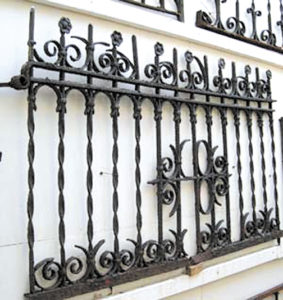 By Anne Gilbert
By Anne Gilbert Once upon a time salvage yards were budget-priced treasure troves for antique and vintage fences and gates. That all changed a couple of decades ago.
A new category was born as “architectural artifacts.” Specialty dealers began offering them with high price tags, along with other architectural remnants. These days there are even expensive reproductions. Historically, decorative ironwork had its American beginnings around the middle of the 18th century. Early examples were made by hammers and anvils. By the 19th century they were produced in foundries. By the mid 19th century there weren’t enough craftsmen who could make the needed quantity.
Foundries began issuing pattern catalogues. Not only new patterns were created but antique designs from other countries. Spanish motifs were especially popular.
Victorian houses were surrounded by a variety of ornate iron fences and gates. Government buildings were protected by fancy iron fences and gates.
Not only homes and commercial buildings were fenced in, but large cemetery tracts were surrounded by elaborate iron fences and gates. Popular subjects were weeping willows and mourning doves.
Still on view today are the ornate early examples in New Orleans, some dating to the 18th century.
Popular patterns took their themes from nature such as fruit and flowing vines. Even quilt and coverlet patterns such as shells, arrows and grapes found their way into pattern books.
During the 1840s the number of foundries kept growing, especially in Philadelphia. The Philadelphia firm of Wood and Perot was the first to make castings for decorative purposes. Their patterns spread across the country
 CLUES: These days you can buy reproductions of antique fences in steel even at Wal-Mart. The authentic antique cast iron or wrought fences and gates cost thousands of dollars. So do vintage examples. If you like the look try a single gate added to whatever kind of fencing you have. Check out examples on Craig’s List or EBay. Maybe you’ll find a bargain.
CLUES: These days you can buy reproductions of antique fences in steel even at Wal-Mart. The authentic antique cast iron or wrought fences and gates cost thousands of dollars. So do vintage examples. If you like the look try a single gate added to whatever kind of fencing you have. Check out examples on Craig’s List or EBay. Maybe you’ll find a bargain. PHOTO CAPTION: (1) 19th century antique wrought iron gate PHOTO CREDIT: The Demolition Depot .PHOTO CAPTION: (2) 19th century wrought iron gate PHOTO CREDIT: Milehannabelle Co.















Follow Us